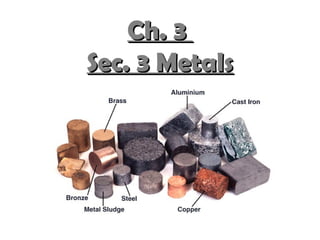
7th grade ch. 3 sec. 3 metals
- 1. Ch. 3 Sec. 3 Metals
- 3. physical properties of a metal • hardness • shininess • malleable =can be pounded into shapes • ductile =can be pulled out into a long wire • conductor - can transmit heat & electricity • magnetic • most are solids at room temp. mercury (except ___________ )
- 4. malleable can be pounded into shapes
- 5. malleable can be pounded into shapes
- 6. chemical properties of a metal reactivity • __________= ease & speed at which an element combines or reacts with other elements • some - very reactive (ie. sodium) • others - unreactive (ie. gold)
- 7. • reactivity ease & speed at __________= which an element combines or reacts with other elements • some - very reactive (ie. sodium)
- 8. Chunk of sodium in school pond
- 9. corrosion •process of reaction & wearing away •ie. iron rusting
- 10. alloy • mixture of metals • ie. copper + tin= bronze
- 11. Metals in the Periodic Table
- 12. Group 1- alkali metals – from Li Fr (not H) – very, very reactive Potassium reacting with water – have 1 valence electron Lithium reacting with water
- 15. Group 2- alkaline earth metals • 2nd column • Be Ra • very reactive- never alone • lose 2 valence electrons • most common- Ca & Mg
- 19. Groups 3-12 - transition metals • bridge between very reactive metals & less reactive metals – ex: Fe, Ag, Pt
- 20. Groups 13-16 – incl metals, nonmetals & metalloids – ex. Al, Sn, Pb
- 21. lanthanides & actinides- rare earth elements • found @ bottom of periodic table • fit in periods 6 & 7 • placed at bottom for convenience
- 22. Neodymium, one of the lanthanide elements, is used in manufacturing the tiny speakers inside stereo headphones.
- 23. Curium, one of the actinide elements, is used as a source of high-energy particles that heat and provide power for certain scientific equipment aboard the Mars Exploration Rover.
- 24. synthetic elements • elements w/ atomic # > 92 • not found naturally on Earth • made when nuclear particles collide
- 25. particle accelerators • make elements above atomic #95 • move atomic nuclei until reach very high speeds
- 26. unununium
- 27. ununilium
- 28. • Element 110-118, elements with three-letter symbols, have been given temporary names and symbols. • In the future, scientists around the world will agree on permanent names and symbols for these elements.